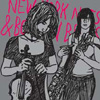 Splitting off briefly from usual drummer Chris Corsano, Burning Star Core's C. Spencer Yeh and experimental jazz elder statesman Paul Flaherty embarked on a brief Northeast jaunt in the closing months of summer, 2007. Taking full advantage of the abandoned rhythm section, the violin and saxophone duo lose none of their power or chaotic potential while skillfully wielding the precise interactions allowed for in such an intimate musical setting. A logical addition is found in trumpeter Greg Kelley's inclusion on two of the pieces, as his breathy playing fits neatly in with the obtuse sonics explored throughout.
Splitting off briefly from usual drummer Chris Corsano, Burning Star Core's C. Spencer Yeh and experimental jazz elder statesman Paul Flaherty embarked on a brief Northeast jaunt in the closing months of summer, 2007. Taking full advantage of the abandoned rhythm section, the violin and saxophone duo lose none of their power or chaotic potential while skillfully wielding the precise interactions allowed for in such an intimate musical setting. A logical addition is found in trumpeter Greg Kelley's inclusion on two of the pieces, as his breathy playing fits neatly in with the obtuse sonics explored throughout.
Given that these pieces are primarily violin and saxophone duets, and that both members have a penchant for jazz inspired work—Yeh in groups such as the New Monuments, a trio featuring percussionist Ben Hall and Borbetomagus sax demolitionist Don Dietrich; Flaherty in groups including Orange and Cold Bleak Heat—it may be a surprise to find that, while these improvisations surely call upon the free jazz tradition, they are not overtly such.
Both Yeh and Flaherty are among a burgeoning few who traverse the grounds between free jazz and the underground experimental and noise camps, and it is this diversity which allows for such fertile material to be chiseled throughout the proceedings. Yeh's violin is nimble, but rarely does a clean tone or traditional bowing tactic reveal itself. Rather, his instrument is sonically ground down to its very elements, just wood and string, from which he creates any number of scrapes, whispers and shrieks. Flaherty too is well versed in a "sound as sound" approach, having played with members of No-Neck Blues Band and Sunburned Hand of the Man among many, and his saxophone dives from Ornette Coleman-like runs to deep crevices of saxophone bellow and airy fluttering.
Yeh also displays a penchant for vocals, as on the second track from a show at Issue Project Room in Brooklyn. With elastic verbalizings, Yeh belches and guffaws sounds that fit right into his violin approach, even mixing in harmonica at one point. This experimental versatility is impressive, but more impressive is the fact that he gets away with it. Flaherty's lack of playing allows Yeh enough space to turn his voice into its own odd sonic landscape, a necessity in its avoidance of seeming mere self-indulgence, and in lesser hands it might. But Yeh's control and energy mean that it is as effective as any other instrument on display. That Flaherty joins in to end the piece in a torrential duet only makes the approach all the more effective.
When Kelley steps in on the fourth and fifth tracks, both recorded at the Nom D'Artiste in Boston, his breathy play weaves effortlessly into the duo's folds. With plenty of experience playing with both representatives here, Kelley is more than comfortable in this environment. Like Bill Dixon filtered down to mere wind and brass, his broad trumpet tones stretch across the tumultuous landscape above, providing a subtle touch without being rendered useless or lost in the anarchic mix.
That these duets are so successful is testament not only to the abilities of those performing, but also to the health of experimental music in general. Yeh and Flaherty are astute improvisers whose interest in music spans gaps that, in this climate of interconnectivity and availability, need to at last be spanned, i.e. noise and free jazz, lower case improv and drone, and a whole slew of other subforms whose similarities number far greater than their differences. These recordings are a display of three key representatives in a burgeoning subculture that is quietly doing just that, albeit through some pretty noisy means.
samples:
Read More

